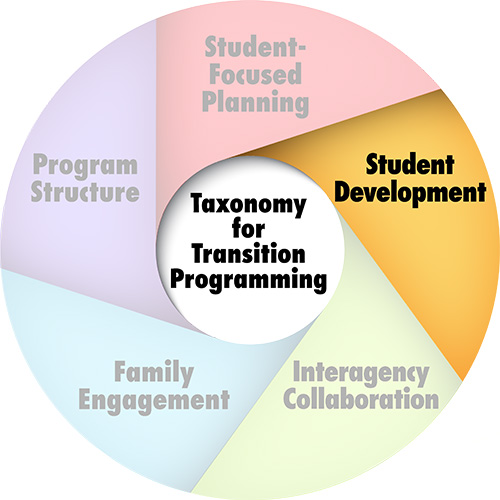How can educators help support students in the transition planning process?
Page 5: Student Development
 Closely related to student-focused planning is student development. This component involves helping students learn the knowledge, skills, and behaviors necessary to achieve their postsecondary goals. Once the IEP team has agreed upon the student’s postsecondary and annual instructional goals, educators should identify and implement effective instructional strategies to support student development in areas such as:
Closely related to student-focused planning is student development. This component involves helping students learn the knowledge, skills, and behaviors necessary to achieve their postsecondary goals. Once the IEP team has agreed upon the student’s postsecondary and annual instructional goals, educators should identify and implement effective instructional strategies to support student development in areas such as:
- Academics
- Occupation and employment skills
- Life, social, and emotional skills
- Self-determination
Below are four strategies that educators can use to teach a wide range of skills in different areas.
Technology-aided instruction and intervention (TAII) is a type of instruction in which electronic or virtual tools are used to help students learn content or skills. These include but are not limited to computer-assisted instruction (CAI) (e.g., software, web-based platforms, mobile apps), virtual reality simulations, and augmentative and alternative communication (AAC) devices. For example, a student might use an interactive computer program to practice work-related social skills. Another student might access step-by-step instructions to cook a simple recipe using a smartphone app. In the video below, Mia demonstrates how she uses TAII to help complete a nighttime routine (time: 2:54).
computer-assisted instruction (CAI)
Instruction that makes use of computer technology (e.g., software, web-based platforms, mobile apps) to teach content or skills.
augmentative and alternative communication (AAC)
A family of alternative methods of communication used by individuals who are unable to readily communicate via speech; these methods can include communication boards and books as well as computerized voices.
Transcript: Mia
Mia: Hi, my name is Mia, and I’m going to show you how to do my nighttime routine.
Mom: First activity is “wash hands.” She has thirty seconds.
[Mia washes her hands in the kitchen sink.]
Mia: Five, four, three, two, one!
[The tablet computer chimes.]
Mom: Close the water. You did it! Dry your hands, and you’re done. Dry your hands. Okay, and you come here and put it on “all done.”
[Mia presses buttons on the tablet computer’s screen.]
Tablet computer: Wash hands…all done.
Mom: Set the table.
[Mia collects utensils from a drawer.]
Mia: I need forks.
Mom: A fork and a knife, please. Just for you. Just for you. Okay.
[Mia sets the kitchen table]
Mom: You’re doing such a great job. I like how you’re setting the table. You have twenty-nine seconds. That is great, Mia. All right. Done?
Mia: Done. All done.
[Mia presses buttons on the tablet computer’s screen.]
Tablet computer: All done.
Mia: Wow! I beat up the timer!
Mom: You did beat the timer. Now what is next. What is next?
[Mia folds napkins and places them on the placemats.]
Mom: Oh, she is folding the napkins. Thank you. So everybody will have something nice. Good, good, and now it’s time to sit.
[Mia sits at the table.]
Mom: Very good.
Mia: Oh, look how Lady is drinking her water.
Mom: It is drinking her water. Okay. And all done sitting?
Mia: Thanks for watching!
[Mia presses buttons on the tablet computer’s screen.]
Tablet computer: All done.
Mia: Bye-bye!
Mom: I’m going to eat my dinner.
Note: TAII is often used in combination with other practices, such as those described on this page.
Community-based instruction is a research-based practice for creating authentic opportunities to learn skills in natural environments. For example, a student might learn how to use a shopping list while visiting the grocery store, navigate the local public transit system using a smartphone app, or practice occupational safety skills in an internship placement.
research-based practice
A practice for which multiple studies have been conducted but the research does not clearly demonstrate that the practice led to improved child or student outcomes; some research studies have demonstrated positive effects on student outcomes while others have not.
In these interviews, Matt Korolden discusses the importance of community-based instruction. Next, he offers examples of community-based instruction in the areas of education and training, employment, and community engagement and independent living.

Matt Korolden, MS, LLP
Transition Consultant
Department of Special Populations
Importance of Community-Based Instruction (time: 1:12)
Examples of Community-Based Instruction (time: 3:32)
Transcript: Matt Korolden, MS, LLP: Importance of Community-Based Instruction
The importance of structured or goal-based community-based instruction is really found in the intentionality—creating and making available to students in real time, in a pragmatic application, those experiences that develop and strengthen the skills and aptitudes that will be important and necessary for post-school success. The importance of this kind of learning is really found in the students having the opportunity to practice or demonstrate in real time and to get feedback in real time in the environments where they’re going to need to be able to do these things in the future without the support of a paraeducator, without the support of a teacher, without the support of a job coach. The community-based instruction becomes really critical in the generalization of the skills and abilities that teachers and educators are working on every day.
Transcript: Matt Korolden, MS, LLP: Examples of Community-Based Instruction
A great example of community-based instruction in the area of education and training would be something like the Prep program, a special education program that is colocated on the campus of one of our community colleges. When students participate in that program, they start to become responsible for many of the same things that young adults who are attending colleges, managing their own schedule, managing their own transportation, managing their own finances around related expenses that occur in the everyday lives of young adults who are doing 20-year-old things, not young adults who are stuck in systems where they keep doing middle school things or high school things. Programs like Prep are really great examples of putting that community-based instruction in the environment where those young adults are going to need to apply the skills that they’re learning on a daily basis in a very pragmatic way.
In terms of employment, Oxford schools operates an adult transition program. The Loft program is centered around a business model that allows the students to do very high-end catering. Those students learn not just the specific skills related to cooking and food prep and presentation and those kinds of things, but they also learn what’s involved in putting together the menu. They also learn what’s involved in working with entities outside of the school system, so they do catering for local businesses in their community. The students in a program like Loft—which is really geared more towards students with fairly significant disabilities—they are still learning those very pragmatic, very applicable skills first in the classroom, then within their school, and then in interacting with the community at large as they cater and develop and organize events outside of the school system.
When thinking about independent living, many of our school districts partner with OU Cares, a grant-funded project at Oakland University that specifically caters to students on the spectrum. And what OU Cares offers are everything from very specific, almost course-like learning opportunities to game night. They also do social night. They do movie night. They partner and coordinate with some of the local movie theaters in doing sensory-friendly showings of first-run movies.
Video modeling is an evidence-based practice in which a student watches a brief recorded demonstration of a skill being performed correctly before engaging in that specific skill themselves. For example, a student might watch a video of themselves completing each step required for doing a load of laundry as they follow along in real time, or they might watch a video of a peer modeling conversation skills for a job interview before participating in a mock interview.
evidence-based practice (EBP)
Skills, techniques, and strategies that have been shown to work through experimental research studies or large-scale research field studies; the criteria for identification of these practices varies by organization or agency.
Self-management strategies, sometimes called self-regulation strategies, refer to those a student can use to independently monitor and modify their behavior. These strategies include:
- Self-monitoring: Students learn to self-assess and record their behavior
- Self-instruction: Students learn to talk themselves through a task or activity
- Goal-setting: Students learn how to set a goal and monitor their progress toward achieving it
- Self-reinforcement: Students learn how to reward themselves for reaching a goal
Although these research-based strategies can be used separately, they are often combined. For instance, a student might set a goal to finish their homework by dinnertime each night. They self-monitor by checking off each completed item on a checklist as they work on their homework, and if they finish on time, reward themselves with 30 minutes of video games after dinner.
For more information about self-management strategies, see the following IRIS Module:
![]() For more effective practices, review this resource from NTACT:C.
For more effective practices, review this resource from NTACT:C.
Effective Practices in Secondary Transition: Operational Definitions
Along with using effective teaching strategies, educators can support student development by tailoring supports to students’ individual needs, preferences, and aspirations. Specifically, transition-related supports for students with disabilities can include:
- Accommodations
- Assistive technology (e.g., braille notetakers, text-to-speech)
- Related services (e.g., occupational therapy, transportation)
- Academic support and enrichment (e.g., study skills instruction, summer enrichment)
- College and career counseling services
- Community-based programs (e.g., social services, mental health services)
braille notetaker
Portable devices that can be used to take notes in braille, which are then converted to speech, braille, or text.
text-to-speech
A technology feature that reads digital text aloud.
study skills
Skills that students can use to strategically approach academic tasks in order to gain and use information effectively.
Returning to the Challenge
Learn about the strategies Carly’s and Omar’s teams use for student development.
 Once the IEP team has agreed on Carly’s postsecondary and annual transition goals, her educators begin implementing various strategies to support her development of academic, occupational, and life skills needed to achieve the postsecondary goals. For example, through community-based instruction, Carly is able to practice financial skills like opening a bank account and purchasing items independently. Carly and her team also identified goals in social communication, which will be important for a job in healthcare. Because of Carly’s strengths and interest in technology, her teacher introduces her to a technology-based program that allows her to practice both social conversations and job-related communication skills such as greeting clients and answering basic questions.
Once the IEP team has agreed on Carly’s postsecondary and annual transition goals, her educators begin implementing various strategies to support her development of academic, occupational, and life skills needed to achieve the postsecondary goals. For example, through community-based instruction, Carly is able to practice financial skills like opening a bank account and purchasing items independently. Carly and her team also identified goals in social communication, which will be important for a job in healthcare. Because of Carly’s strengths and interest in technology, her teacher introduces her to a technology-based program that allows her to practice both social conversations and job-related communication skills such as greeting clients and answering basic questions.
 Omar’s teachers have employed various strategies to support his learning and progress toward achieving his goals. Specifically, learning self-management strategies (e.g., using a daily planner and setting reminders on his phone) has helped Omar improve his organization and stay on track with assignments. The team agrees that Omar continues to require academic accommodations, including having preferential seating away from distractions, breaking down large assignments into smaller parts, and using assistive technology to aid in note-taking and organization.
Omar’s teachers have employed various strategies to support his learning and progress toward achieving his goals. Specifically, learning self-management strategies (e.g., using a daily planner and setting reminders on his phone) has helped Omar improve his organization and stay on track with assignments. The team agrees that Omar continues to require academic accommodations, including having preferential seating away from distractions, breaking down large assignments into smaller parts, and using assistive technology to aid in note-taking and organization.